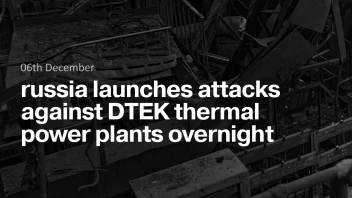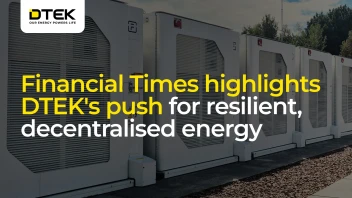A lot has changed in Ukraine in the three decades since independence, both politically and socially. However, one thing has always remained constant: the country’s importance as a strategic energy provider in Europe. In particular, Ukraine’s oil and gas sector has been at the heart of European energy security, and continues to show tremendous potential for further growth as well as opportunities for investment.
The use of new technologies and consolidation of international partnerships has driven the success of the Ukrainian oil and gas sector, allowing it to engage in world-class collaborative partnerships. The impact has been immensely positive for the country, its economy and, ultimately, for our people.
An indicator for Ukraine’s international significance in the global energy market is the fact that in 2019, Ukraine was, for the first time, included in the renowned Baker Hughes Rig Count index. A subsequent Baker Hughes report in 2020 listed Ukraine as European leader in the volume of machines involved in oil and gas drilling operations. Also, in 2017 the European Federation of Energy Traders included Ukraine in the ranking of Europe gas hubs for the first time.
None of this is surprising given the country’s large resource potential, which producers now start to uncover. According to BP Statistical Review of World Energy 2020, Ukraine ranks the second in Europe after Norway in terms of proven gas reserves that amount to 1.1 tcm. Also, the country is a leader in terms of R/P ratio, which amounts to 55.7 and is three times higher than the European average.
New impetus from the private sector
While public sector companies belonging to the Naftogaz group lead in the distribution and production of Ukrainian gas, private gas producers provide the sector with new impetus,actively implement modern technology and steadily increase gas production in the country. In 2019, private companies both boosted production by 5% and recorded unprecedented production numbers, with the extraction of 4.6 billion cubic meters (bcm) of natural gas. For some companies, gas production rose by 50% or more thanks to new wells, as well as the introduction of modern technology.
DTEK is a real-life example of such dynamics at work. DTEK Oil&Gas, Ukraine's largest private gas company, has a share of 36% in Ukraine’s private gas production market. In recent years, DTEK Oil&Gas has more than tripled its gas production. In 2019, the company reached a new all-time high for gas production in the private gas sector, with a total amount equalling 1.66 bcm. Even better, the company increased the rate of its withdrawal of stocks from 4-5% to 15-17%, against a 10-12% average in Ukraine and Europe. The returns from this growth in production, and its transportation, are providing additional investment for the energy sector.
Investment climate revival as a key growth driver
In 2018, Ukraine introduced an incentive tax on gas production - a rent for new gas wells of 6% and 12% depending on the depth. During the two years of the incentive tax in effect, almost 200 new wells were drilled, which is an evidence of the effectiveness of such tax implementation.
In 2019, for the first time in many years, Ukraine held oil and gas auctions and PSA competitions. In total, 42 blocks with a total area of 29,000 sq. km were exhibited for licensing rounds. Open and fair trading of subsoil use permits caused a vivid interest in the domestic market and attracted the attention of international companies, including the Canadian Vermilion Energy, the American Aspect Energy and the Slovak Nafta RV. Of particular interest is a competition for concluding PSA agreements as one of the most important reputable projects in terms of attracting investments. The advantages of working under PSA conditions for investors are protection against legislative changes, international arbitration, reimbursement of costs, the large size of the territories provided for use, and the long term of the agreements. The agreements are to be concluded in January 2021. Negotiations are ongoing, there are many issues that still need to be agreed, nevertheless, investors are determined to sign the agreements within the specified period. The international community is closely monitoring the signing of the PSA, as it is an indicator of the investment climate in Ukraine.
One of the world’s largest gas transportation and storage systems
Reinvesting the revenue raised from the taxation into the midstream sector has been particularly important in maintaining the competitiveness and development of the broader sector. Ukraine's gas transportation system is one of the largest in the world, consisting of main gas pipelines, distribution networks, gas storage facilities, compressors and measuring stations. And the Ukrainian gas transportation system (UKRGTS) has remained integrated with the systems in Russia, Belarus, Poland, Slovakia, Hungary, Romania and Moldova, through interconnecting pipelines. Moreover, Ukraine has a lot to offer particularly in terms of gas storage. The country’s underground storage facilities have over 14 bcm of free storage that can be rented to European partners.
Transit capacity from the main gas pipelines in Ukraine amounts to 145 bcm per year from Russia to EU countries, and around 30 bcm per year from Russia to Greece and Turkey. However, only 30% of the UKRGTS capacity to the EU is currently used and just 5% of the southern capacity is in use.
This is because of the launch of Gazprom’s Nord Stream 1 and Turkish Stream. On top of that, with the imminent introduction of Nord Stream 2, Russia plans to abandon the use of the UKRGTS by the end of 2024. This will cause a significant shortfall: the current five-year contract is worth $7 billion.
The natural gas transport sector reform was completed in 2019
The UKRGTS operator has earmarked $1.5 billion in its ten-year development plan, to futureproof Ukraine’s pipeline transportation industry. This will largely be spent on the maintenance of critical infrastructure, such as compressors.
Simultaneously, Ukraine is devising several new opportunities for UKRGTS. For example, the country insists that Russia opens up the potential of gas transit to Central Asian countries, providing alternative hydrocarbon sources for Europe.
Also, UKRGTS operator became a member of the European Clean Hydrogen Alliance and now looks into opportunities connected with hydrogen transportation, which is particularly important in the context of the EU Green Deal and Europe’s carbon reduction endeavours.
In fact, the EU’s regulatory and legislative frameworks have been particularly influential in shaping the development of Ukraine’s gas sector. A good example is that Ukraine completed the reform of its the natural gas transport sector in 2019, in accordance with the EU’s Third Energy Package. Also, currently, experts work on an annex to the agreement of the European Federation of Energy Traders (EFET), that will simplify gas trading operations.
Focus on hydrogen
The EU Green Deal will also have a significant impact Ukraine’s gas sector..
Growing political support in Europe for natural gas’ role as a transition fuel in the Green Deal is driving demand for gas. This is opening new possibilities for Ukraine to strengthen cooperation with European and international companies in the field of gas production, storage and transportation.
In the face of changing realities, be it through the COVID-19 pandemic or the new energy landscape driven by the EU Green Deal, the Ukraine’s oil and gas sector’s ability to adapt will ensure it remains a leading player in Central and Eastern Europe. Through continued world-class partnerships, both external and internal investments and favourable investment climate opportunities, the country’s growth is being further strengthened.
It is clear that close geographic proximity to European markets, the abundant potential of its subsoil and a well-established gas pipeline system means Ukraine continues to be undoubtedly very attractive for potential international investors. The future awaits.
Yulia Borzhemska, Head of GR, DTEK Oil&Gas







